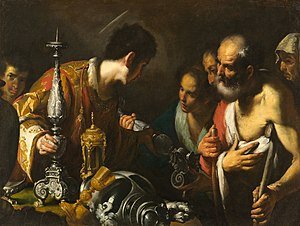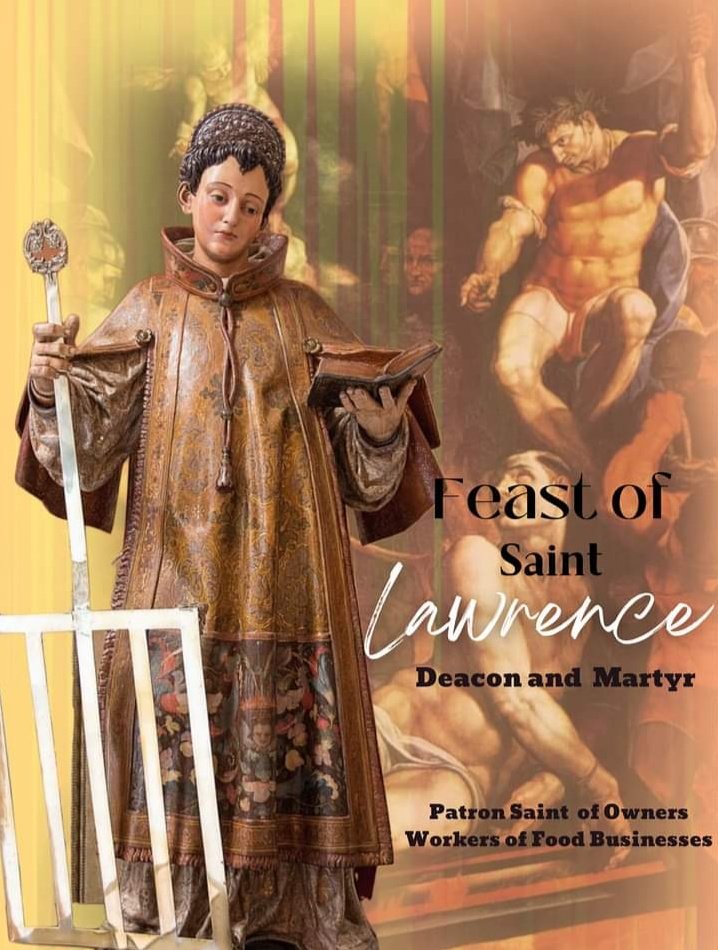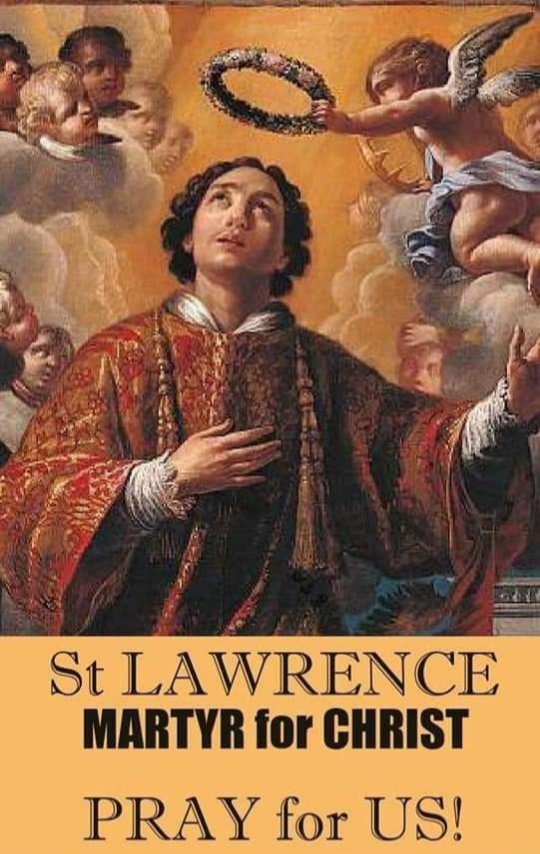FEAST OF SAINT LAWRENCE, DEACON AND MARTYR
FEAST DAY – 10th AUGUST
Saint Lawrence or Laurence (Latin: Laurentius, lit. “laurelled”; 31 December AD 225 –10 August 258) was one of the seven deacons of the city of Rome under Pope Sixtus II who were martyred in the persecution of the Christians that the Roman Emperor Valerian ordered in 258. Lawrence encountered the future Pope Sixtus II, who was of Greek origin and one of the most famous and highly esteemed teachers, in Caesaraugusta (today Zaragoza). Eventually, both left Spain for Rome.
When Sixtus became the Pope in 257, he ordained Lawrence as a deacon, and though Lawrence was still young, appointed him first among the seven deacons who served in the cathedral church. St. Lawrence was thought to have been born on 31 December AD 225, in Valencia, or less probably, in Huesca, the town from which his parents came in the later region of Aragon that was then part of the Roman province of Hispania Tarraconensis.
The martyrs Orentius (Modern Spanish: San Orencio) and Patientia (Modern Spanish: Santa Paciencia) are traditionally held to have been his parents. Lawrence encountered the future Pope Sixtus II, who was of Greek origin and one of the most famous and highly esteemed teachers, in Caesaraugusta (today Zaragoza).
Eventually, both left Spain for Rome. When Sixtus became the Pope in 257, he ordained Lawrence as a deacon, and while still being young Lawrence was also appointed first among the seven deacons who served in the cathedral church by Sixtus. He is therefore called “archdeacon of Rome”, a position of great trust that included the care of the treasury and riches of the Church and the distribution of alms to the indigent.

St. Cyprian, Bishop of Carthage, notes that Roman authorities had established a norm according to which all Christians who had been denounced must be executed and their goods confiscated by the Imperial treasury. At the beginning of August 258, the Emperor Valerian issued an edict that all bishops, priests, and deacons should immediately be put to death. Pope Sixtus II was captured on 6 August 258, at the cemetery of St. Callixtus while celebrating the liturgy and executed forthwith.
After the death of Sixtus, the prefect of Rome demanded that Lawrence turn over the riches of the Church. St. Ambrose is the earliest source for the narrative that Lawrence asked for three days to gather the wealth. He worked swiftly to distribute as much Church property to the indigent as possible, so as to prevent it being seized.
On the third day, at the head of a small delegation, he presented himself to the prefect, and when ordered to deliver the treasures of the Church he presented the indigent, the crippled, the blind, and the suffering, and declared that these were the true treasures of the Church. One account records him declaring to the prefect, “The Church is truly rich, far richer than your emperor.” This act of defiance led directly to his martyrdom and can be compared to the parallel Roman tale of the jewels of Cornelia.
On 10 August, Lawrence, the last of the seven deacons, and therefore, the ranking Church official, suffered a martyr’s death. As a deacon in Rome, Lawrence was responsible for the material goods of the Church and the distribution of alms to the poor. Ambrose of Milan relates that when the treasures of the Church were demanded of Lawrence by the prefect of Rome, he brought forward the poor, to whom he had distributed the treasure as alms.

“Behold in these poor persons the treasures which I promised to show you; to which I will add pearls and precious stones, those widows and consecrated virgins, which are the Church’s crown.” The prefect was so angry that he had a great gridiron prepared with hot coals beneath it and had Lawrence placed on it, hence Lawrence’s association with the gridiron.
After the martyr had suffered pain for a long time, the legend concludes, he cheerfully declared: “I’m well done on this side. Turn me over!” From this, St. Lawrence derives his patronage of cooks, chefs, and comedians. Lawrence was sentenced at San Lorenzo in Miranda, imprisoned in and baptized fellow prisoners at San Lorenzo in Fonte, martyred at San Lorenzo in Panisperna, and was buried in San Lorenzo fuori le Mura.
The Almanac of Filocalus for 354 states that he was buried in the Catacomb of Cyriaca on the Via Tiburtina by Hippolytus and Justin the Confessor, a presbyter. One of the early sources for his martyrdom was the description of Aurelius Prudentius Clemens in his Peristephanon, Hymn 2.
Emperor Constantine I is held to have erected a small oratory in honour of Lawrence, which was a station on the itineraries of the graves of the Roman martyrs by the seventh century. Pope Damasus I rebuilt or repaired the church, now the Basilica di San Lorenzo fuori le Mura, while the Minor Basilica of San Lorenzo in Panisperna was erected over the site of his martyrdom.

The gridiron of the martyrdom was placed by Pope Paschal II in the Minor Basilica of San Lorenzo in Lucina. The life and miracles of Lawrence were collected in The Acts of St Lawrence but those writings have been lost. The earliest existing documentation of miracles associated with him is in the writings of Gregory of Tours (538–594), who mentions the following:
A priest named Fr. Sanctulus was rebuilding a church of St. Lawrence, which had been attacked and burnt, and hired many workmen to accomplish the job. At one point during the construction, he found himself with nothing to feed them. He prayed to St. Lawrence for help, and looking in his basket he found a fresh, white loaf of bread. It seemed to him too small to feed the workmen, but in faith he began to serve it to the men. While he broke the bread, it so multiplied that his workmen fed from it for ten days.
The mediaeval Church of St Mary Assumed (Chiesa di Santa Maria Assunta) in the small commune of Amaseno, Lazio, Italy houses the famous reliquary of the ampulla containing relics of Lawrence, namely a quantum of his blood, a fragment of his flesh, some fat and ashes. Tradition holds that annually, on the Feast of St. Lawrence, and sometimes on other occasions, the blood in the ampulla miraculously liquefies during the Feast and re-coagulates by the following day.
Lawrence is one of the most widely venerated saints of the Roman Catholic Church. Legendary details of his death were known to Damasus, Prudentius, Ambrose, and Augustine. Devotion to him was widespread by the fourth century. His liturgical celebration on 10 August has the rank of feast in the General Roman Calendar, consistent with the oldest of Christian calendars, e. g. the Almanac of Philocalus for the year 354, the inventory of which contains the principal feasts of the Roman martyrs of the middle of the fourth century.

He remains one of the saints enumerated in the “Roman Canon” of the Holy Mass as celebrated in the Latin Church. Lawrence is especially honoured in the city of Rome, of which he is considered the third patron after St. Peter and St. Paul. The church built over his tomb, the Papal Minor Basilica di San Lorenzo fuori le Mura, became one of the seven principal churches of Rome and a place of Roman pilgrimages.
The area proximate to the Basilica di San Lorenzo fuori le Mura is named the “Quartiere San Lorenzo”. Because the Perseid Meteor Shower typically occurs annually in mid-August on or proximate to his feast day, some refer to the shower as the “Tears of St Lawrence”.
His intercession to God is invoked by librarians, archivists, comedians, cooks and tanners as their patron. He is the patron saint of Ampleforth Abbey, whose Benedictine monks founded one of the world’s leading public schools for Catholics, located in North Yorkshire (North East England).
On his feast the reliquary containing his burnt head is displayed in the St. Peter’s Basilica for veneration. Within Anglicanism Lawrence’s name is traditionally spelled Laurence or Lawrence. His feast is on 10 August which is in the calendar of the Book of Common Prayer, the volume of prayers which, in its 1662 format, was the founding liturgical document of a majority of Anglican provinces.

In the Book of Common Prayer the feast is titled “S Laurence, Archdeacon of Rome and Martyr”. His feast on 10 August has been carried into the contemporary calendars of most Anglican provinces, Laurence is remembered in the Church of England with a Lesser Festival under the title “Laurence, deacon, martyr, 258” on 10 August.
Anglo-Catholics venerate Lawrence, who is the patron of many Anglican parish churches, including 228 in England. A major church in Sydney, Australia, in the former civil parish of St Laurence, is known as “Christ Church St Laurence”. The Anglican charitable society, Brotherhood of St Laurence also bears his name.
PRAYER
O Generous patron of the Church’s poor, St. Lawrence, pray to the One God, Father, Son and Holy Spirit that all the poor of the Church in need in every corner of the world may feel the effect of the love of their brothers and sisters who seek to help them.
Deliver the Church from the greed and envy of the powerful and protect her rights and property so that she may serve the needy in freedom, giving them good things for soul and body.
May we come some day with all those whom we helped on earth to the bright mansions of heaven where we will enjoy the riches of God’s house and the company of the Savior who lives and reigns forever and ever. Amen.
( Source of prayer: aleteia.org )







